INTRODUCTION
I'm not eloquent enough to put into words the heart stopping experience you get from the crescendo of sound that announces an African dawn, not to mention the glorious sunsets only massive African skies can produce. The Sun-downer is a glorification of this event and is exclusive to the African continent. Having travelled to many points on the compass in the pursuit of birds there's a magical feeling you only get in Africa. India comes close, but Africa does it for us. The big skies, the chance encounters with exotic wildlife, the people and that hint of trepidation you can sometimes experience, all help to make birding on the African continent something very, very special.

 Our chosen destination for this trip was Tanzania: the country has a very large bird list, good infrastructure, a well established tourist industry, plus it gave us another chance to see the big game Tanzania is famous for. It also gave us the opportunity to visit those magical reserves that we have grown up with, first encountered on black & white TV with David Attenborough and Armand & Michaela Denis: The Serengeti, Ngorongoro Crater, Tarangire and Lake Manyara.
Our chosen destination for this trip was Tanzania: the country has a very large bird list, good infrastructure, a well established tourist industry, plus it gave us another chance to see the big game Tanzania is famous for. It also gave us the opportunity to visit those magical reserves that we have grown up with, first encountered on black & white TV with David Attenborough and Armand & Michaela Denis: The Serengeti, Ngorongoro Crater, Tarangire and Lake Manyara.
Having chosen the itinerary, date, and standard of accommodation, we once again contacted Birding Africa to pull it all together. We used them on our South African trip and found them to be extremely professional, efficient and great to do business with. We would wholeheartedly recommend Birding Africa as the company to choose when planning an African trip. The duration of the trip would be 14 days and we would concentrate our efforts on the tried & tested birding route of Northern Tanzania; Arusha, Tarangire, Ndutu, (southern Serengeti), Ngorongoro Crater and Lake Manyara.
GETTING THERE
Although not ideal, we chose KLM as our long haul Airline. This meant we could fly from Birmingham (our local airport) rather than fly from London or Manchester. KLM also fly to Kilimanjaro International rather than just Dar Es Salaam or Nairobi. Going with the main British carriers would have meant taking a local flight to Kilimanjaro from either of the two airports previously mentioned. The downside with KLM meant that we would fly B'ham/Amsterdam/Kilimanjaro going out and Kilimanjaro/Dar Es Salaam/Amsterdam/B'ham on the return - not ideal. Let's hope that when Birmingham's new runway extension is completed travel from our local airport will be greatly expanded and improved.

 A visa is required for British visitors; be aware the visa is only valid for 3 months so don't be tempted to acquire it too early. The cost of each visa is presently £40-00. There is an option to acquire a visa on arrival, but if you are like us, you want to be away from the airport and start your birding a.s.a.p. Malaria is present so a course of anti-malaria tablets is essential.
A visa is required for British visitors; be aware the visa is only valid for 3 months so don't be tempted to acquire it too early. The cost of each visa is presently £40-00. There is an option to acquire a visa on arrival, but if you are like us, you want to be away from the airport and start your birding a.s.a.p. Malaria is present so a course of anti-malaria tablets is essential.
We were informed by Birding Africa that independent travellers are strongly recommended to employ a Tanzanian driver/guide. You would find it extremely difficult to find your way yourself around Tanzania, limited signage and many detours don't help, especially as many lodges used are well off the beaten track. Tanzania is one of the safest African countries for the independent traveller to visit; using local guides is a way of getting badly needed resources into the local economy, something we are more than happy to contribute to.
Birding Africa have been birding in Tanzania for a decade, so they have built up a relationship with several driver/guides; we were therefore happy to let them select ours. They use D/G's that have a good working knowledge of Tanzanian birds but probably wouldn't be adept in some of the more obscure bird calls/songs or be able to positively identify a raptor several kilometres up in silhouette. They do however know the northern Tanzanian birding circuit, the various rest camps and have a good working relationship with their staff. This all helps to make for a more enjoyable trip as it allows us to concentrate on the birding, letting the guide deal directly with the camp staff over meal times, early breakfasts, picnic lunches etc. Their relationship with the various camp guides can also be beneficial; they may get that little bit of information with regards to locations of birds and animals that perhaps wouldn't be as forthcoming to ourselves.

 As we prefer to identify the birds ourselves this wasn't of great concern to us. We have found that identifying birds yourself gives greater satisfaction and greatly enhances the chance of identifying that species on your next encounter. Ticking off a very brief glimpse of a bird high up in the canopy or silhouetted against a blue African sky, identified by your guide, is not for us and doesn't really help with future identification. We have been in the presence of some very expert birders who have identified birds incorrectly for several very good and plausible reasons. Always remember the old adage, experts built the Titanic!!!
As we prefer to identify the birds ourselves this wasn't of great concern to us. We have found that identifying birds yourself gives greater satisfaction and greatly enhances the chance of identifying that species on your next encounter. Ticking off a very brief glimpse of a bird high up in the canopy or silhouetted against a blue African sky, identified by your guide, is not for us and doesn't really help with future identification. We have been in the presence of some very expert birders who have identified birds incorrectly for several very good and plausible reasons. Always remember the old adage, experts built the Titanic!!!
The total cost of the holiday was approximately £10k. This included everything except items of a personal nature, drinks and tips etc. We were recommended very good accommodation, all based on full board with some lunches taken in picnic form and consumed in the field.
DAY 1
Our first day, was a full days travel. We left home at 04:00 travelling the 30 minute trip to the airport in dense fog making the trip nearer 1hr. We arrived at the airport worried that our flight may be delayed, putting in doubt our connecting flight in Amsterdam. Our concerns were unfounded and we left Birmingham and arrived at Schipol bang on time. Our flight to Kilimanjaro was also on time and possibly the smoothest long haul flight we have ever had, hardly a hint of turbulence in over 8hrs flying; again our arrival at Kilimanjaro was spot on. I waited in the baggage hall whilst Jude went off to the bureau-de-change to exchange pounds for Tanzanian shillings. Luck was on our side with both bags arriving simultaneously in the first tranche of baggage. I found Jude at the bureau-de-change and was soon meeting our driver/guide Peter who greeted us warmly like long lost friends.
Kia Lodge was within the confines of the airport so we were having a cool beer and ham sandwich with 1 hour of arrival. Our room was adequate for an overnight stay, although the beds were on the small side and the mattress was made of granite, making for a poor night's sleep; perhaps the poor sleep could also be attributed to excitement!! Noting the bathroom window was open I tried to close it twice without success. Frustration setting in I pulled the window shut with more force, a gecko shot across the wall with its tail dropping onto the toilet cistern wriggling violently for a full 10 minutes, "welcome to Africa".
DAY 2
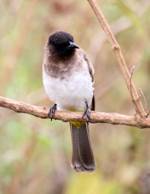 We awoke early the next morning to a typical African "dawn chorus" to find light rain falling. A spot of birding around the lodge produced the usual suspects, Mourning Dove, Ring-necked Dove, our only White-bellied Go-away-bird of the trip, Speckled Mousebird, Dark- capped Bulbul and several Icterine Warblers.
We awoke early the next morning to a typical African "dawn chorus" to find light rain falling. A spot of birding around the lodge produced the usual suspects, Mourning Dove, Ring-necked Dove, our only White-bellied Go-away-bird of the trip, Speckled Mousebird, Dark- capped Bulbul and several Icterine Warblers.
After a light breakfast we re-united with Peter and drove the 1hr to Arusha National Park where we birded until lunch on the verdant slopes of Mount Meru. We had lunch at Hatari Lodge and rested in our room until late afternoon when we returned to Arusha National Park birding until dusk. It's not our intention to clutter the report with photos of the lodges we stayed in, suffice to say that all the information required and photo galleries can be found on the "net". We will however give our own personal opinion of each lodge stayed at.
 Hatari Lodge was a very comfortable lodge, within walking distance of Arusha National Park. The main building was given over to bar, lounge and dining room. There were 9 rooms. All rooms and public spaces were very well appointed and furnished to a very high standard. The lodge is set in landscaped grounds with good views of both Meru and Kilimanjaro (weather permitting). Food was of a very high standard with international cuisine being the norm. Both management and staff were very accommodating and we would have no hesitation in recommending Hatari as a place to stay. A call of "Massai" would bring a warrior to escort you to and from your rooms. This is wild Africa, so it is not uncommon to have wild animals passing either close to, or through, the camp. Indeed during our stay we had Warthogs grazing within a meter of our room and watched 3 bull Buffalo pass within metres of the room.
Hatari Lodge was a very comfortable lodge, within walking distance of Arusha National Park. The main building was given over to bar, lounge and dining room. There were 9 rooms. All rooms and public spaces were very well appointed and furnished to a very high standard. The lodge is set in landscaped grounds with good views of both Meru and Kilimanjaro (weather permitting). Food was of a very high standard with international cuisine being the norm. Both management and staff were very accommodating and we would have no hesitation in recommending Hatari as a place to stay. A call of "Massai" would bring a warrior to escort you to and from your rooms. This is wild Africa, so it is not uncommon to have wild animals passing either close to, or through, the camp. Indeed during our stay we had Warthogs grazing within a meter of our room and watched 3 bull Buffalo pass within metres of the room.
Day 3
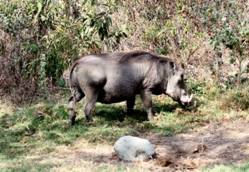 After a good night's sleep and a light breakfast we set of for the Momella lakes. This is a series of lakes set in small arid valleys where the various habitats hold a good number of bird species - a totally different environment to the lush forested slopes of Mount Meru, which cover much of the northern part of the park.
After a good night's sleep and a light breakfast we set of for the Momella lakes. This is a series of lakes set in small arid valleys where the various habitats hold a good number of bird species - a totally different environment to the lush forested slopes of Mount Meru, which cover much of the northern part of the park.
"Big Momella" is soda rich and ideal for Flamingos which are there in their thousands. Several wader and duck species were also found foraging amongst the reed fringed margins.
We returned to the lodge at 13:30 for lunch and a rest during the hottest part of the day, we were out again by 15:30, returning to the slopes of Mount Meru principally in search of Hartlaub's Turaco a spectacularly plumaged bird we had heard but not seen the previous day. This was where Peter's previous experiences with other birding groups paid off. 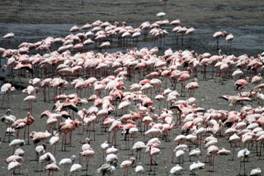 We drove to public camping site No 2, which was an area of short mown grass with toilet & washing facilities, set deep in the forest. As this was the low season the site was deserted and the facilities locked. Peter's hunch soon paid off as we heard the calls of a distant Turaco. Good scoped views were had of a calling bird in the top of a distant tree. The photo below was taken the next day as we drove through the park to our next destination, where 2 birds were feeding in road-side bushes. According to some publications, Arusha National Park is often overlooked by visitors determined to get to some of the more famous reserves, Ngorongoro and the Serengeti; this is a shame to our minds as the park holds a lot of both birds and animals. Giraffe and Elephant were particularly abundant.
We drove to public camping site No 2, which was an area of short mown grass with toilet & washing facilities, set deep in the forest. As this was the low season the site was deserted and the facilities locked. Peter's hunch soon paid off as we heard the calls of a distant Turaco. Good scoped views were had of a calling bird in the top of a distant tree. The photo below was taken the next day as we drove through the park to our next destination, where 2 birds were feeding in road-side bushes. According to some publications, Arusha National Park is often overlooked by visitors determined to get to some of the more famous reserves, Ngorongoro and the Serengeti; this is a shame to our minds as the park holds a lot of both birds and animals. Giraffe and Elephant were particularly abundant.
Birds seen during our stay at Arusha
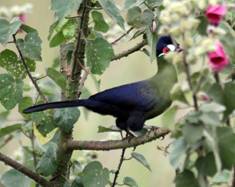 Helmeted Guineafowl, Crested Francolin, Red-billed Teal, Hottentot Teal, Southern Pochard, Little Grebe, Sanderling, Lesser Flamingo, Yellow-billed Stork, African Sacred Ibis, Hadada Ibis, Cattle Egret, Hamercop, African Fish Eagle, White-backed Vulture, African Harrier Hawk, Augur Buzzard, Crowned Eagle, Lanner Falcon, Blacksmith Plover, Crowned Lapwing, Mourning Dove, Ring-necked Dove, Hartlaub's Turaco, White-bellied Go-away-bird, Speckled Mousebird, Grey-headed Kingfisher, Little Bee-eater, Cinnamon-chested Bee-eater, White-fronted Bee-eater, Black-throated Barbet, African Hoopoe, Nubian Woodpecker, Slate-coloured Boubou, Tropical Boubou, Northern Fiscal, Black-headed Oriole, African Paradise Flycatcher, Pied Crow, Rufous-naped Lark, Dark-capped Bulbul, Brown-throated Martin, Wire-tailed Swallow, Rock Martin, Lesser-striped Swallow, Moustached Grass Warbler, Mountain Yellow Warbler, Icterine Warbler, Rattling Cisticola, Yellow-breasted Apalis, Grey-backed Camaroptera, Abyssinian White-eye, Superb Starling, Violet-backed Starling, Red-winged Starling, Red-billed Oxpecker, Cape Robin Chat, African Stonechat, Spotted Flycatcher, Amethyst Sunbird, Scarlet-chested Sunbird, Variable Sunbird, House Sparrow, Baglafecht Weaver, Speke's Weaver, African Pied Wagtail, Pangani Longclaw, Streaky Seedeater.
Helmeted Guineafowl, Crested Francolin, Red-billed Teal, Hottentot Teal, Southern Pochard, Little Grebe, Sanderling, Lesser Flamingo, Yellow-billed Stork, African Sacred Ibis, Hadada Ibis, Cattle Egret, Hamercop, African Fish Eagle, White-backed Vulture, African Harrier Hawk, Augur Buzzard, Crowned Eagle, Lanner Falcon, Blacksmith Plover, Crowned Lapwing, Mourning Dove, Ring-necked Dove, Hartlaub's Turaco, White-bellied Go-away-bird, Speckled Mousebird, Grey-headed Kingfisher, Little Bee-eater, Cinnamon-chested Bee-eater, White-fronted Bee-eater, Black-throated Barbet, African Hoopoe, Nubian Woodpecker, Slate-coloured Boubou, Tropical Boubou, Northern Fiscal, Black-headed Oriole, African Paradise Flycatcher, Pied Crow, Rufous-naped Lark, Dark-capped Bulbul, Brown-throated Martin, Wire-tailed Swallow, Rock Martin, Lesser-striped Swallow, Moustached Grass Warbler, Mountain Yellow Warbler, Icterine Warbler, Rattling Cisticola, Yellow-breasted Apalis, Grey-backed Camaroptera, Abyssinian White-eye, Superb Starling, Violet-backed Starling, Red-winged Starling, Red-billed Oxpecker, Cape Robin Chat, African Stonechat, Spotted Flycatcher, Amethyst Sunbird, Scarlet-chested Sunbird, Variable Sunbird, House Sparrow, Baglafecht Weaver, Speke's Weaver, African Pied Wagtail, Pangani Longclaw, Streaky Seedeater.
DAY 4
Tarangire National Park
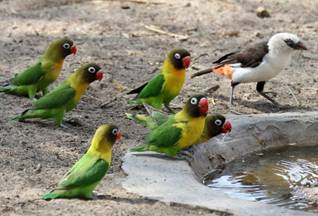 Peter had warned us that due to road construction between Arusha and Tarangire there were many detours, so today was to be a long day travelling. Saying our good-byes we left Hatari a little after 09:00, arriving at Tarangire National Park main gate after a bone shaking ride at 13:30.
Peter had warned us that due to road construction between Arusha and Tarangire there were many detours, so today was to be a long day travelling. Saying our good-byes we left Hatari a little after 09:00, arriving at Tarangire National Park main gate after a bone shaking ride at 13:30.
Paperwork completed, we decided to eat our lunch at the picnic site attached to the main entrance. We picnicked in the shade of a bandstand type building in the company of Ashy Starling, Yellow-collared Lovebird, White-headed Buffalo Weaver, Blue-capped Cordon-bleu, Grey-headed Sparrow, Superb Starling and Grey Woodpecker, all using an adjacent small concrete pool to drink and bathe.
After lunch we birded the park arriving at Tarangire Balloon Camp at 17-15.
Tarangire Balloon Camp
Set inside the park on an elevated position in thick Acacia scrub some 38 kilometres from the main gate, the permanent camp consisted of a main building containing bar, lounge and dining room, (much the same set up as Hatari), plus 9 spacious, luxury tents, with possibly the best bathroom of the whole trip. Each tent was elevated off the ground and each had a veranda containing table and chairs. Both the public areas and the tents were furnished to a very high standard with a bed that must have been over 2.5 metres across. Each tent had an electric fan that did help to cool the tent once the sun went down. All the food was plentiful and very well cooked and presented. Both management and staff were very friendly and very obliging. Asked if we had had a good night's sleep we commented that the bed was a little creaky, which woke us on occasions. A brand new bed was installed during our next day's birding. As the tents were situated a little way from the main building a Massai escort service was provided, again just like Hatari. Once again we would thoroughly recommend the Balloon Camp as a place to stay in Tarangire.
DAY 5
 Our next few days were spent exploring the various habitats the park had to offer. With the Tarangire River holding water in all but the worst droughts the park holds a large head of animals as well as birds. The swamp was visited during our first full day in the park with many familiar water birds encountered as well as the more exotic. Things got a little exciting when we found ourselves a little too close to a herd of elephants being harassed by an amorous bull Elephant, it was time to turn off the engine and sit tight. Although the 2 protagonists came close to our vehicle they had other things on their minds, or at least the bull did.
Our next few days were spent exploring the various habitats the park had to offer. With the Tarangire River holding water in all but the worst droughts the park holds a large head of animals as well as birds. The swamp was visited during our first full day in the park with many familiar water birds encountered as well as the more exotic. Things got a little exciting when we found ourselves a little too close to a herd of elephants being harassed by an amorous bull Elephant, it was time to turn off the engine and sit tight. Although the 2 protagonists came close to our vehicle they had other things on their minds, or at least the bull did.  A most enjoyable days birding and game drive, returning back to the balloon Camp by 16-00hrs for a delicious evening meal around the camp fire.
A most enjoyable days birding and game drive, returning back to the balloon Camp by 16-00hrs for a delicious evening meal around the camp fire.
DAY 6
Our second full day in the park was spent following the river which runs north/west through the park, emptying in Lake Burunge which is set outside the park’s boundaries. Lunch was taken at Silale picnic site. Once again Peter's advice was invaluable; he explained that because of illegal feeding by tourists the Baboons had become habituated and were now dangerous, stealing food when the situation allowed. Indeed during our lunch a large male attacked the adjacent table of Chinese, intimidating the occupants and dashing off with someone's lunch. Many birds and animals were seen including 3 different prides of lions. We returned to the Balloon camp by 16:00 and enjoyed another delicious evening meal and a sound night's sleep.
Birds seen during our stay at Tarangire
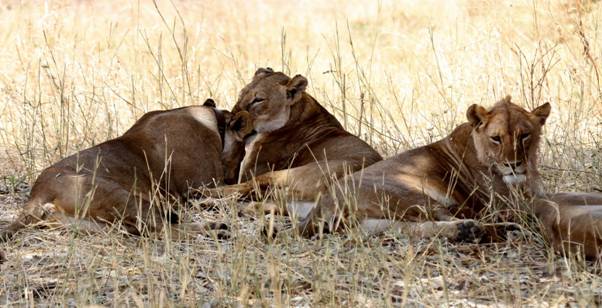 Ostrich, Coqui Francolin, Crested Francolin, Yellow-necked Spurfowl, Red-necked Spurfowl, Spur-winged Goose, Knob-billed Goose, Egyptian Goose, Red-billed Teal, Hotentot Teal, Little Grebe, African Openbill, African Sacred Ibis, Hadada Ibis, Glossy Ibis, African Spoonbill, Squacco Heron, Cattle Egret, Black-headed Heron, Little Egret, Hamerkop, African Fish Eagle, White-backed Vulture, Rüppell's Vulture, Lappet-faced Vulture, Brown Snake Eagle, Bateleur, Eastern Chanting Goshawk, Augur Buzzard, Tawny Eagle, Martial Eagle, Pygmy Falcon, Common Moorhen, Purple Swamphen, Red-knobbed Coot, Water Thick-knee, Black-winged Stilt, Long-toed Lapwing, Blacksmith Lapwing, Crowned Lapwing, Three-banded Plover, Greater Painted-snipe, African Jacana, Green Sandpiper, Marsh Sandpiper, Greenshank, Wood Sandpiper, Little Stint, Ruff, Collared Pratincole, Whiskered Tern, White-winged Tern, Chestnut-bellied Sandgrouse, Black-faced Sandgrouse, Mourning Dove, Ring-necked Dove, Laughing Dove, Emerald-spotted Wood Dove, Namaqua Dove, Yellow-collared Lovebird, Red-bellied Parrot, Bare-faced Go-away-bird, White-bellied Go-away-bird, Lilac-breasted Roller, Grey-headed Kingfisher, Little Bee-eater, White-fronted Bee-eater, African Hoopoe, Green Wood-hoopoe, Abyssinian Scimitarbill, African Grey Hornbill, Tanzanian Red-billed Hornbill, Von der Decken's Hornbill, Southern Ground Hornbill, Red-fronted Barbet, Spot-flanked Barbet, Eastern Grey Woodpecker, Magpie Shrike, Northern White-crowned Shrike, Long-tailed Fiscal, Fork-tailed Drongo, Pied Crow, Dark-capped Bulbul, Grey-rumped Swallow, Wire-tailed Swallow, Mosque Swallow, Red-rumped Swallow, Red-faced Crombec, Tawny-flanked Prinia, Grey-backed Camaroptera, Northern Pied Babbler, Wattled Starling, Greater Blue-eared Starling, Superb Starling, Ashy Starling, Red-billed Oxpecker, White-browed Robin Chat, Scarlet-chested Sunbird, Rufous-tailed Weaver, Northern Grey-headed Sparrow, Red-billed Buffalo Weaver, White-headed Buffalo Weaver, Speckle-fronted Weaver, Taveta Weaver, African Firefinch, Red-cheeked Cordon-bleu, Blue-capped Cordon-bleu.
Ostrich, Coqui Francolin, Crested Francolin, Yellow-necked Spurfowl, Red-necked Spurfowl, Spur-winged Goose, Knob-billed Goose, Egyptian Goose, Red-billed Teal, Hotentot Teal, Little Grebe, African Openbill, African Sacred Ibis, Hadada Ibis, Glossy Ibis, African Spoonbill, Squacco Heron, Cattle Egret, Black-headed Heron, Little Egret, Hamerkop, African Fish Eagle, White-backed Vulture, Rüppell's Vulture, Lappet-faced Vulture, Brown Snake Eagle, Bateleur, Eastern Chanting Goshawk, Augur Buzzard, Tawny Eagle, Martial Eagle, Pygmy Falcon, Common Moorhen, Purple Swamphen, Red-knobbed Coot, Water Thick-knee, Black-winged Stilt, Long-toed Lapwing, Blacksmith Lapwing, Crowned Lapwing, Three-banded Plover, Greater Painted-snipe, African Jacana, Green Sandpiper, Marsh Sandpiper, Greenshank, Wood Sandpiper, Little Stint, Ruff, Collared Pratincole, Whiskered Tern, White-winged Tern, Chestnut-bellied Sandgrouse, Black-faced Sandgrouse, Mourning Dove, Ring-necked Dove, Laughing Dove, Emerald-spotted Wood Dove, Namaqua Dove, Yellow-collared Lovebird, Red-bellied Parrot, Bare-faced Go-away-bird, White-bellied Go-away-bird, Lilac-breasted Roller, Grey-headed Kingfisher, Little Bee-eater, White-fronted Bee-eater, African Hoopoe, Green Wood-hoopoe, Abyssinian Scimitarbill, African Grey Hornbill, Tanzanian Red-billed Hornbill, Von der Decken's Hornbill, Southern Ground Hornbill, Red-fronted Barbet, Spot-flanked Barbet, Eastern Grey Woodpecker, Magpie Shrike, Northern White-crowned Shrike, Long-tailed Fiscal, Fork-tailed Drongo, Pied Crow, Dark-capped Bulbul, Grey-rumped Swallow, Wire-tailed Swallow, Mosque Swallow, Red-rumped Swallow, Red-faced Crombec, Tawny-flanked Prinia, Grey-backed Camaroptera, Northern Pied Babbler, Wattled Starling, Greater Blue-eared Starling, Superb Starling, Ashy Starling, Red-billed Oxpecker, White-browed Robin Chat, Scarlet-chested Sunbird, Rufous-tailed Weaver, Northern Grey-headed Sparrow, Red-billed Buffalo Weaver, White-headed Buffalo Weaver, Speckle-fronted Weaver, Taveta Weaver, African Firefinch, Red-cheeked Cordon-bleu, Blue-capped Cordon-bleu.
DAY 7
Ndutu plains, Southern Serengeti
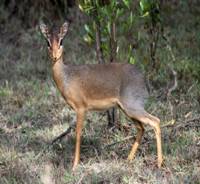 Another moving day, over the worst corrugated road we have travelled on in Africa, so bad was the road that the door adjacent to where Judy was sitting kept springing open, one of the metal stays on the pop-up roof broke and the windscreen wiper arm was constantly shaken onto the on position; all this on a brand new vehicle (see moans, groans & memorable moments at the end of this report).
Another moving day, over the worst corrugated road we have travelled on in Africa, so bad was the road that the door adjacent to where Judy was sitting kept springing open, one of the metal stays on the pop-up roof broke and the windscreen wiper arm was constantly shaken onto the on position; all this on a brand new vehicle (see moans, groans & memorable moments at the end of this report).
Shaken but not stirred, we arrived at Ndutu Lodge in time for lunch. Having been bounced about for several hours we decided to spend the afternoon unwinding and unpacking. A spot of birding around the camp with Peter was done in the late afternoon, once it had cooled off.
Ndutu Lodge
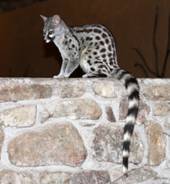 Ndutu was the largest of the camps we had thus far visited and again followed the familiar theme of centrally located public areas with the rooms radiating off both to the right and left. The rooms were either detached or semi-detached each with a veranda containing an integral bench. Although this was the biggest of the lodges visited this did not detract from its charms, set under large flat-topped Acacias and looking over "Typical Africa" open savannah interspersed with Acacia trees. Movement was continually catching your eye whether it was Jackals chasing Impala, distant grazing animals, the resident Dikdiks or just a large flock of Guineafowl there was always something to demand your attention. The lodge was not only a great stopping off point on the way to the Serengeti, but was also a wonderful place just to relax and take stock of the trip so far. Well furnished rooms, comfortable lounge and super food. Both management and staff were genuinely very friendly and obliging.
Ndutu was the largest of the camps we had thus far visited and again followed the familiar theme of centrally located public areas with the rooms radiating off both to the right and left. The rooms were either detached or semi-detached each with a veranda containing an integral bench. Although this was the biggest of the lodges visited this did not detract from its charms, set under large flat-topped Acacias and looking over "Typical Africa" open savannah interspersed with Acacia trees. Movement was continually catching your eye whether it was Jackals chasing Impala, distant grazing animals, the resident Dikdiks or just a large flock of Guineafowl there was always something to demand your attention. The lodge was not only a great stopping off point on the way to the Serengeti, but was also a wonderful place just to relax and take stock of the trip so far. Well furnished rooms, comfortable lounge and super food. Both management and staff were genuinely very friendly and obliging.
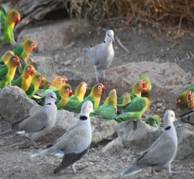 Ndutu was a firm favourite and a camp we could have spent a lot more time at. The resident Genets that lived in the bar were a great source of entertainment and a firm favourite with all the visitors, I would imagine they are probably the most photographed animals in Africa. Add the Dikdiks that wandered around the grounds unafraid of human presence, the Buffalo Weavers and Starlings that would take popcorn from the hand and the spectacle that was the kaleidoscope of colour at the bird bath and you have something really special.
Ndutu was a firm favourite and a camp we could have spent a lot more time at. The resident Genets that lived in the bar were a great source of entertainment and a firm favourite with all the visitors, I would imagine they are probably the most photographed animals in Africa. Add the Dikdiks that wandered around the grounds unafraid of human presence, the Buffalo Weavers and Starlings that would take popcorn from the hand and the spectacle that was the kaleidoscope of colour at the bird bath and you have something really special.
DAY 8
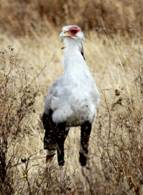 With ongoing tummy troubles Jude decided to have a quiet day relaxing at the Lodge. Breakfasted, Peter and I set off to the Marsh. This is an area that holds water even during the driest of seasons, indeed on our visit the marsh stood out from the dry arid surrounds as a large verdant area of green vegetation with a thin ribbon of water along its edge. The drive to the marsh was through several kilometres of acacia scrub, producing the bird species associated with such terrain. Secretarybirds were evident in the more open areas.
With ongoing tummy troubles Jude decided to have a quiet day relaxing at the Lodge. Breakfasted, Peter and I set off to the Marsh. This is an area that holds water even during the driest of seasons, indeed on our visit the marsh stood out from the dry arid surrounds as a large verdant area of green vegetation with a thin ribbon of water along its edge. The drive to the marsh was through several kilometres of acacia scrub, producing the bird species associated with such terrain. Secretarybirds were evident in the more open areas.
On reaching the marsh we found a male lion with several females slumbering in the semi-shade adjacent to the marsh. Several water birds were feeding in the open water; many familiar species with a smattering of African species.  A trip onto the grass plain looking for Cheetah produced a blank. With temperatures rising to uncomfortable levels we returned to the lodge to find Jude relaxing on the veranda with a good book. It was decided that we would call our afternoon game drive off and we would spend the afternoon relaxing in the very comfortable lounge and working on the trip photos on the mini laptop we had with us. Again a late afternoon walk around the grounds was taken. One of the lodge workers showed us a couple of bat roosts: one was identified as Yellow-winged Bat. This was a very large bat that showed large lemon yellow wings. The second roost contained much smaller unidentified bats. Jude noticed a couple of Spotted Thick-knee in the shade of a small Acacia so I spent the next 20 minutes edging closer in order to obtain a decent photo. Dinner was taken at 20:00hrs and another good night's sleep was taken despite the crescendo of cicadas, the first we were aware of since arriving in Africa.
A trip onto the grass plain looking for Cheetah produced a blank. With temperatures rising to uncomfortable levels we returned to the lodge to find Jude relaxing on the veranda with a good book. It was decided that we would call our afternoon game drive off and we would spend the afternoon relaxing in the very comfortable lounge and working on the trip photos on the mini laptop we had with us. Again a late afternoon walk around the grounds was taken. One of the lodge workers showed us a couple of bat roosts: one was identified as Yellow-winged Bat. This was a very large bat that showed large lemon yellow wings. The second roost contained much smaller unidentified bats. Jude noticed a couple of Spotted Thick-knee in the shade of a small Acacia so I spent the next 20 minutes edging closer in order to obtain a decent photo. Dinner was taken at 20:00hrs and another good night's sleep was taken despite the crescendo of cicadas, the first we were aware of since arriving in Africa.
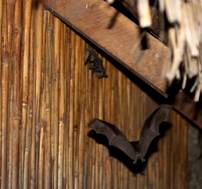 DAY 9
DAY 9
It had been our intention to visit Lake Masek today, a large soda lake close to the lodge, but as Jude had missed the marsh the previous day we decided to retrace our steps, spending more time on the vast Ndutu plains looking for Cheetah, a species we were desperate to see. It was an animal that had eluded us during visits to Namibia, Botswana and South Africa. Arriving on the plains the quest looked hopeless, grass spread like a straw-coloured carpet to every horizon. 2 hours of traversing the plains produced many Secretarybird, lots of small brown jobs which were unidentified, as well as several Sandgrouse, but not a sign of anything bearing four legs and fur.
We were just about to give up and head for the marsh when a simultaneous shout of Cheetah from both Jude and Peter saw us speeding over the plain to get a better look. A female Cheetah with 2 cubs in tow, what luck. We accompanied the Cheetahs at a respectful distance for about half an hour.  The female walked slowly, stopping at intervals to scan the horizon for what we assumed was prey and to let the cubs catch up. The cubs appeared tired and would take every opportunity to rest, usually in the shade of any tall vegetation. On leaving the Cheetahs we noted a very distant safari vehicle flashing his headlights. This vehicle contained several Americans with a Swahili driver; he told Peter that he had struggled all morning to find anything worthwhile to show the occupants. Peter said we had just left a Cheetah & cubs and the driver begged Peter to take him to where we had seen them. Peter got our agreement and somehow took the other vehicle to the vicinity of the Cheetahs. We left the Americans admiring close views of some very special creatures. A subsequent email from one of the occupants told how they watched the female bring down a Grant’s Gazelle and how she shared the kill with her cubs.
The female walked slowly, stopping at intervals to scan the horizon for what we assumed was prey and to let the cubs catch up. The cubs appeared tired and would take every opportunity to rest, usually in the shade of any tall vegetation. On leaving the Cheetahs we noted a very distant safari vehicle flashing his headlights. This vehicle contained several Americans with a Swahili driver; he told Peter that he had struggled all morning to find anything worthwhile to show the occupants. Peter said we had just left a Cheetah & cubs and the driver begged Peter to take him to where we had seen them. Peter got our agreement and somehow took the other vehicle to the vicinity of the Cheetahs. We left the Americans admiring close views of some very special creatures. A subsequent email from one of the occupants told how they watched the female bring down a Grant’s Gazelle and how she shared the kill with her cubs.
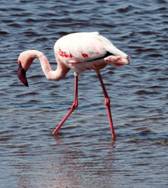 We then visited the marsh where we saw very little different from the previous day’s visit. We returned to the lodge for lunch and stayed for the remainder of the day, talking birds and other things with Aadje (Owner) and Ainslie (Lodge Manager); it really is hard to tear yourself away!
We then visited the marsh where we saw very little different from the previous day’s visit. We returned to the lodge for lunch and stayed for the remainder of the day, talking birds and other things with Aadje (Owner) and Ainslie (Lodge Manager); it really is hard to tear yourself away!
DAY 10
Unfortunately we had to leave Ndutu today but not before a good breakfast and the visit to Lake Masek, which had been postponed from the previous day. Masek is another soda lake, one of many that make up the lakes of the rift valley. As with all these lakes they mainly attract Flamingos but the odd wader and duck can be found picking up brine flies along the margins.
Birds seen during our stay at Ndutu
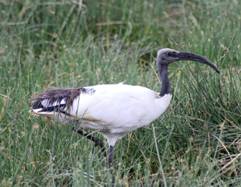 Ostrich, Helmeted Guinea Fowl, Coqui Francolin, Crested Francolin, Yellow-necked Spurfowl, Grey-breasted Spurfowl, Egyptian Goose, Red-billed Teal, Greater Flamingo, Marabou Stork, African Sacred Ibis, Hadada Ibis, Glossy Ibis, Grey Heron, Black-headed Heron, Secretarybird, Black-winged Kite, Black Kite, White-backed Vulture, Rüppell's Vulture, Lappet-faced Vulture, Brown Snake Eagle, Bateleur, Pallid Harrier, Augur Buzzard, Tawny Eagle, Long-crested Eagle, Pygmy Falcon, White-bellied Bustard, Water Thick-knee, Spotted Thick-knee, Black-winged Stilt, Pied Avocet, Blacksmith Lapwing, Crowned Lapwing, Ringed Plover, Kittlitz's Plover, Three-banded Plover, Chestnut-banded Plover, Wood Sandpiper, Common Sandpiper, Little Stint,
Ostrich, Helmeted Guinea Fowl, Coqui Francolin, Crested Francolin, Yellow-necked Spurfowl, Grey-breasted Spurfowl, Egyptian Goose, Red-billed Teal, Greater Flamingo, Marabou Stork, African Sacred Ibis, Hadada Ibis, Glossy Ibis, Grey Heron, Black-headed Heron, Secretarybird, Black-winged Kite, Black Kite, White-backed Vulture, Rüppell's Vulture, Lappet-faced Vulture, Brown Snake Eagle, Bateleur, Pallid Harrier, Augur Buzzard, Tawny Eagle, Long-crested Eagle, Pygmy Falcon, White-bellied Bustard, Water Thick-knee, Spotted Thick-knee, Black-winged Stilt, Pied Avocet, Blacksmith Lapwing, Crowned Lapwing, Ringed Plover, Kittlitz's Plover, Three-banded Plover, Chestnut-banded Plover, Wood Sandpiper, Common Sandpiper, Little Stint, 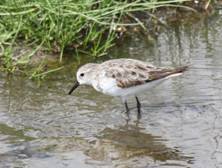 Curlew Sandpiper, Sanderling, Ruff, Double-banded Courser, Gull-billed Tern, Chestnut-bellied Sandgrouse, Yellow-throated Sandgrouse, Ring-necked Dove, Laughing Dove, Namaqua Dove, Fischer's Lovebird, Yellow-collared Lovebird, Red-bellied Parrot, White-browed Coucal, Pearl-spotted Owlet, Speckled Mouse Bird, Lilac-breasted Roller, Little Bee-eater, Cinnamon-chested Bee-eater, European Bee-eater, Africa Hoopoe, Abyssinian Scimitarbill, Von der Decken's Hornbill, Red-fronted Barbet, Usambiro Barbet, Bearded Woodpecker, Eastern Grey Woodpecker, Slate-coloured Boubou, Brubru, Northern White-crowned Shrike, Northern Fiscal, Fork-tailed Drongo, African Paradise Flycatcher, Southern-black Flycatcher, Red-capped Lark, Fischer's Sparrow Lark, Dark-capped Bulbul, Mosque Swallow, Black-lored Babbler, Arrow-marked Babbler, Wattled Starling, Rüppell's Starling, Superb Starling,
Curlew Sandpiper, Sanderling, Ruff, Double-banded Courser, Gull-billed Tern, Chestnut-bellied Sandgrouse, Yellow-throated Sandgrouse, Ring-necked Dove, Laughing Dove, Namaqua Dove, Fischer's Lovebird, Yellow-collared Lovebird, Red-bellied Parrot, White-browed Coucal, Pearl-spotted Owlet, Speckled Mouse Bird, Lilac-breasted Roller, Little Bee-eater, Cinnamon-chested Bee-eater, European Bee-eater, Africa Hoopoe, Abyssinian Scimitarbill, Von der Decken's Hornbill, Red-fronted Barbet, Usambiro Barbet, Bearded Woodpecker, Eastern Grey Woodpecker, Slate-coloured Boubou, Brubru, Northern White-crowned Shrike, Northern Fiscal, Fork-tailed Drongo, African Paradise Flycatcher, Southern-black Flycatcher, Red-capped Lark, Fischer's Sparrow Lark, Dark-capped Bulbul, Mosque Swallow, Black-lored Babbler, Arrow-marked Babbler, Wattled Starling, Rüppell's Starling, Superb Starling, 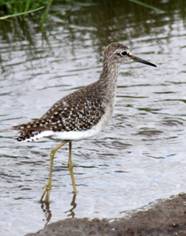 Hildebrandt's Starling, Yellow-billed Oxpecker, Cape Robin Chat, Capped Wheatear, Abyssinian Wheatear, Anteater Chat, Silverbird, Rufous-tailed Weaver, House Sparrow, Northern Grey-headed Sparrow, Swahili Sparrow, Chestnut Sparrow, Red-billed Buffalo Weaver, Speckle-fronted Weaver, Baglafecht Weaver, Red-billed Quelea, Cut-throat Finch, Blue-capped Cordon-bleu, African Pied Wagtail, Yellow-crowned Canary, White-bellied Canary and Streaky Seedeater.
Hildebrandt's Starling, Yellow-billed Oxpecker, Cape Robin Chat, Capped Wheatear, Abyssinian Wheatear, Anteater Chat, Silverbird, Rufous-tailed Weaver, House Sparrow, Northern Grey-headed Sparrow, Swahili Sparrow, Chestnut Sparrow, Red-billed Buffalo Weaver, Speckle-fronted Weaver, Baglafecht Weaver, Red-billed Quelea, Cut-throat Finch, Blue-capped Cordon-bleu, African Pied Wagtail, Yellow-crowned Canary, White-bellied Canary and Streaky Seedeater.
A 2hr drive back along the worst corrugated and dustiest road in Africa saw us arriving at the Serena Lodge Ngorongoro just in time for lunch. As our permit for the crater was for tomorrow we decided to shower away the dust have lunch and then take a stroll around the hotel grounds in the late afternoon.
Serena Lodge Ngorongoro
 With the Lodge perched on the crater rim some 3,137ft higher than Ben Nevis, there was a crispness and purity to the air that we had not experienced since arriving in Africa. The hotel was constructed mainly of highly polished wood and local stone. There was a feeling of opulence, especially in the public areas which were furnished to a very high standard. All rooms had a fantastic view of the crater in its entirety. Herds of animals could be picked out using the telescope several thousand feet below. Our bedroom was originally a slight disappointment, but we put this down to the opulence we had passed through. A veranda with table and chairs looked out over the crater with the large lake to the left, the tract of forest to the right, the extensive swamp in the distance leading to the picnic area, all set in a carpet of burnished gold surrounded by the towering crater walls; no wonder we have read somewhere that it's one of the top located hotels in the world.
With the Lodge perched on the crater rim some 3,137ft higher than Ben Nevis, there was a crispness and purity to the air that we had not experienced since arriving in Africa. The hotel was constructed mainly of highly polished wood and local stone. There was a feeling of opulence, especially in the public areas which were furnished to a very high standard. All rooms had a fantastic view of the crater in its entirety. Herds of animals could be picked out using the telescope several thousand feet below. Our bedroom was originally a slight disappointment, but we put this down to the opulence we had passed through. A veranda with table and chairs looked out over the crater with the large lake to the left, the tract of forest to the right, the extensive swamp in the distance leading to the picnic area, all set in a carpet of burnished gold surrounded by the towering crater walls; no wonder we have read somewhere that it's one of the top located hotels in the world. 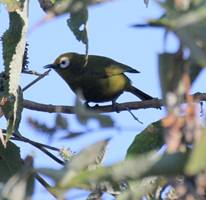 The staff were polite and efficient but lacked the genuine desire to please that had been so evident throughout our trip so far. Meals were a mix of buffet style salads, sweets and vegetarian dishes, soups and main courses were waiter service. The choice of food was far more extensive than we had experienced thus far, although some of the cooking fell short of expectations.
The staff were polite and efficient but lacked the genuine desire to please that had been so evident throughout our trip so far. Meals were a mix of buffet style salads, sweets and vegetarian dishes, soups and main courses were waiter service. The choice of food was far more extensive than we had experienced thus far, although some of the cooking fell short of expectations.
These few shortcomings did detract a little, but we would recommend this hotel both for its opulence and location. Being at such a high altitude the landscape gardens were lush and held a surprising amount of colourful birds.
DAY 11
Ngorongoro Crater
Today was to be our day in the crater, something we had looked forward to since we booked the trip. Breakfast was taken at 07:00 for an 08:00 start in the crater. Bacon & eggs for breakfast were rejected as they were served stone cold, so toast had to suffice. 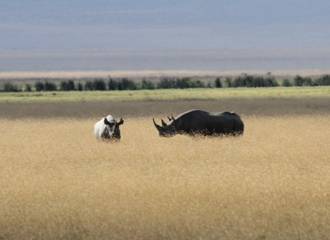 We arrived at the entrance to the crater along with a dozen or so other vehicles. We commenced our decent in convoy, not really what we had in mind and somewhat reminiscent of a glorified safari park. At least once we got to the crater floor the vehicles dispersed along the myriad of trails. It wasn't long before we came across several dozen vehicles all looking at a pair of Black Rhinos; this repeated itself every time Lions, Hyenas, Hippo and Buffalo were spotted. This was the off-season, but even so we ate our lunch at the main picnic area along with at least another 100 vehicles. Peter’s advice to eat our lunch in the vehicle was spot on, as we witnessed Black Kites swooping down and taking food from unsuspecting diners.
We arrived at the entrance to the crater along with a dozen or so other vehicles. We commenced our decent in convoy, not really what we had in mind and somewhat reminiscent of a glorified safari park. At least once we got to the crater floor the vehicles dispersed along the myriad of trails. It wasn't long before we came across several dozen vehicles all looking at a pair of Black Rhinos; this repeated itself every time Lions, Hyenas, Hippo and Buffalo were spotted. This was the off-season, but even so we ate our lunch at the main picnic area along with at least another 100 vehicles. Peter’s advice to eat our lunch in the vehicle was spot on, as we witnessed Black Kites swooping down and taking food from unsuspecting diners.
The birding was good especially for birds of the plain, several new water species were also picked up at the hippo pool. Our allotted 6hrs in the crater was soon up and because of road works we had to leave the crater at the far end leaving an hour's dust choked trip back to the hotel. 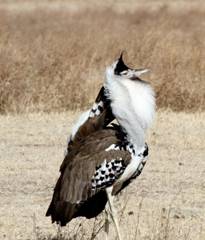 The highlight of the trip was a displaying Kori Bustard, although what he was displaying to was a mystery as there didn't appear to be another Bustard for miles around. A super meal and a good night's sleep saw us packing ready for the trip to Lake Manyara, the last destination of the trip. Breakfast was again interesting; Jude didn't get what she asked for and I was given two semi-raw eggs, so a slice of toast had to suffice again.
The highlight of the trip was a displaying Kori Bustard, although what he was displaying to was a mystery as there didn't appear to be another Bustard for miles around. A super meal and a good night's sleep saw us packing ready for the trip to Lake Manyara, the last destination of the trip. Breakfast was again interesting; Jude didn't get what she asked for and I was given two semi-raw eggs, so a slice of toast had to suffice again.
Birds seen during our stay at Ngorongoro.
Ostrich, Helmeted Guineafowl, Hildebrandt's Francolin, Egyptian Goose, Red-billed Teal, Lesser Flamingo, Marabou Stork, Woolly-necked Stork, Black-headed Heron, Little Egret, Great White Pelican, Reed Cormorant, Secretarybird, Black-winged Kite, Black Kite, Yellow-billed Kite, White-backed Vulture, Lappet-faced Vulture, Augur Buzzard, Steppe Eagle, Kori Bustard, Black Crake, Moorhen, Grey-crowned Crane, Black-winged Stilt, Pied Avocet, Blacksmith Plover, Black-winged Plover, 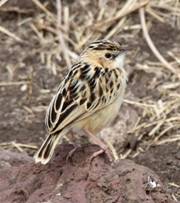 Crowned Lapwing, Common Sandpiper, Little Stint, Curlew Sandpiper, Ruff, Double-banded Courser, Yellow-throated Sandgrouse, Dusky Turtle Dove, Red-eyed Dove, Emerald-spotted Wood Dove, Namaqua Dove, Common Swift, Speckled Mousebird, Lilac-breasted Roller, Grey-headed Kingfisher, Little Bee-eater, Cinnamon-chested Bee-eater, European Bee-eater, African Hoopoe, African Grey Hornbill, Northern Fiscal, Cape Crow, White-necked Raven, Rufous-napped lark, Red-winged Lark, Fischer's Sparrow-Lark, Barn Swallow, Red-rumped Swallow, Zitting Cisticola, Montane White-eye, Wattled Starling, Superb Starling, African Stonechat, Capped Wheatear, Anteater Chat, White-eyed Slaty Flycatcher, Scarlet-chested Sunbird, Tacazze Sunbird, Marico Sunbird, Variable Sunbird, House Sparrow, Thick-billed Weaver, Baglafecht Weaver, Red-billed Quelea, Fan-tailed Widowbird, Mountain Wagtail, and Rosy-throated Longclaw.
Crowned Lapwing, Common Sandpiper, Little Stint, Curlew Sandpiper, Ruff, Double-banded Courser, Yellow-throated Sandgrouse, Dusky Turtle Dove, Red-eyed Dove, Emerald-spotted Wood Dove, Namaqua Dove, Common Swift, Speckled Mousebird, Lilac-breasted Roller, Grey-headed Kingfisher, Little Bee-eater, Cinnamon-chested Bee-eater, European Bee-eater, African Hoopoe, African Grey Hornbill, Northern Fiscal, Cape Crow, White-necked Raven, Rufous-napped lark, Red-winged Lark, Fischer's Sparrow-Lark, Barn Swallow, Red-rumped Swallow, Zitting Cisticola, Montane White-eye, Wattled Starling, Superb Starling, African Stonechat, Capped Wheatear, Anteater Chat, White-eyed Slaty Flycatcher, Scarlet-chested Sunbird, Tacazze Sunbird, Marico Sunbird, Variable Sunbird, House Sparrow, Thick-billed Weaver, Baglafecht Weaver, Red-billed Quelea, Fan-tailed Widowbird, Mountain Wagtail, and Rosy-throated Longclaw.
DAY 12
Lake Manyara
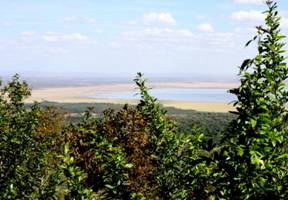 With our last stop a little over an hour's drive away, we left the Ngorongoro Serena hotel a little after 09-30 for a slow drive to its sister hotel Serena Manyara. What a difference; staff that genuinely wanted to serve and please. The hotel was set high on an escarpment with views to Lake Manyara below. It was set in large landscaped grounds, with many flowering shrubs and fruiting trees; 50% of the grounds was covered by well watered lawns. The accommodation was scattered throughout the gardens and consisted of 2 storey circular buildings each containing 4 rooms, the rooms were spacious, well furnished and all came with superb views of the National Park below.
With our last stop a little over an hour's drive away, we left the Ngorongoro Serena hotel a little after 09-30 for a slow drive to its sister hotel Serena Manyara. What a difference; staff that genuinely wanted to serve and please. The hotel was set high on an escarpment with views to Lake Manyara below. It was set in large landscaped grounds, with many flowering shrubs and fruiting trees; 50% of the grounds was covered by well watered lawns. The accommodation was scattered throughout the gardens and consisted of 2 storey circular buildings each containing 4 rooms, the rooms were spacious, well furnished and all came with superb views of the National Park below.
The public areas were very well furnished; 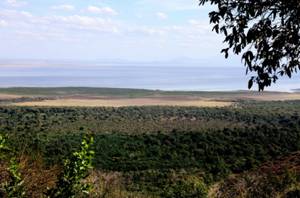 the reception was accessed via a small bridge over a decorative water feature containing fish and noisy frogs whose calls were almost deafening after dark. The bar, lounge and dining room were all open plan blending with the gardens. An infinity swimming pool and an adjacent garden bar was well used by residents and birds alike. The birds used the pool to drink and bathe irrespective whether the pool was being used or not. Meals were served similar to its sister hotel with buffet bar for salads, sweets and vegetarian dishes including pastas. Soups and main courses were waiter-served. All food was very well cooked and plentiful. We would highly recommend this hotel should you wish to visit Manyara National Park. After a nice lunch we unpacked prior to our game drive in Manyara National Park which commenced at 15:30.
the reception was accessed via a small bridge over a decorative water feature containing fish and noisy frogs whose calls were almost deafening after dark. The bar, lounge and dining room were all open plan blending with the gardens. An infinity swimming pool and an adjacent garden bar was well used by residents and birds alike. The birds used the pool to drink and bathe irrespective whether the pool was being used or not. Meals were served similar to its sister hotel with buffet bar for salads, sweets and vegetarian dishes including pastas. Soups and main courses were waiter-served. All food was very well cooked and plentiful. We would highly recommend this hotel should you wish to visit Manyara National Park. After a nice lunch we unpacked prior to our game drive in Manyara National Park which commenced at 15:30.
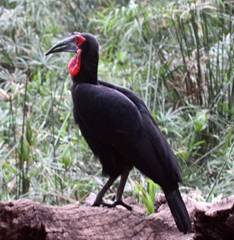 Manyara is made up of ground water forest, bush and the large soda lake which makes up approximately two thirds of the park. Many fresh-water streams criss-cross the reserve giving rise to a very lush forest densely populated with large mature trees. Our trip lasted 3hrs in which time we added several new birds to the trip list. With so many mature trees there is a very large population of hornbills: we saw 5 different species during this trip. We returned to the hotel where we had an excellent evening meal and a good night’s sleep.
Manyara is made up of ground water forest, bush and the large soda lake which makes up approximately two thirds of the park. Many fresh-water streams criss-cross the reserve giving rise to a very lush forest densely populated with large mature trees. Our trip lasted 3hrs in which time we added several new birds to the trip list. With so many mature trees there is a very large population of hornbills: we saw 5 different species during this trip. We returned to the hotel where we had an excellent evening meal and a good night’s sleep.
DAY 13
This was our last full day of the trip to bird; it was decided to spend the morning in the reserve and return for lunch, due to ongoing tummy troubles we would decide on the afternoon after lunch. Our route through the reserve followed much the same as the previous day. A slow drive through the forest before emerging into fragmented plains where most of the grazing animals could be found. Being late in the season the lake had reduced considerably in size, so views of the lake’s birds were distant and distorted by the heat haze.
The Hippo pool gave us the opportunity to get a little closer to the resident storks, ibis, waders etc. Lunch was taken at 13:30 after which we decided to have a rest and bird the extensive grounds later in the afternoon. Another super evening meal brought our last full day to a close.
Birds seen at Lake Manyara
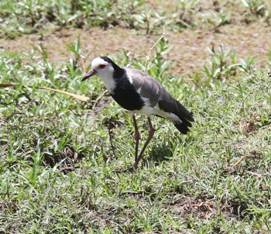 Helmeted Guineafowl, Crested Francolin, Lesser Flamingo, Yellow-billed Stork, White Stork, Hadada Ibis, Glossy Ibis, Cattle Egret, Grey Heron, Black-headed Heron, Intermediate Egret, Little Egret, White-backed Vulture, Rüppell's Vulture, Bateleur, African Harrier Hawk, Augur Buzzard, Martial Eagle, Black Crake, Moorhen, Long-toed Lapwing, Blacksmith Lapwing, Crowned Lapwing, Kittlitz's Plover, African Jacana, Wood Sandpiper, Ruff, Double-banded Courser, Collared Pratincole, Speckled Pigeon, Mourning Collared Dove, Red-eyed Dove, Emerald-spotted Wood Dove, White-browed Coucal, African Palm Swift, Common Swift, Speckled Mousebird, Blue-napped Mousebird, Lilac-breasted Roller, Broad-billed Roller, Grey-headed Kingfisher, Giant Kingfisher, Pied Kingfisher, Little Bee-eater, Crowned Hornbill, African Grey Hornbill, Von der Decken's Hornbill, Silvery-cheeked Hornbill, Southern Ground Hornbill, Red-and-yellow Barbet, D'Arnaud's Barbet, O
Helmeted Guineafowl, Crested Francolin, Lesser Flamingo, Yellow-billed Stork, White Stork, Hadada Ibis, Glossy Ibis, Cattle Egret, Grey Heron, Black-headed Heron, Intermediate Egret, Little Egret, White-backed Vulture, Rüppell's Vulture, Bateleur, African Harrier Hawk, Augur Buzzard, Martial Eagle, Black Crake, Moorhen, Long-toed Lapwing, Blacksmith Lapwing, Crowned Lapwing, Kittlitz's Plover, African Jacana, Wood Sandpiper, Ruff, Double-banded Courser, Collared Pratincole, Speckled Pigeon, Mourning Collared Dove, Red-eyed Dove, Emerald-spotted Wood Dove, White-browed Coucal, African Palm Swift, Common Swift, Speckled Mousebird, Blue-napped Mousebird, Lilac-breasted Roller, Broad-billed Roller, Grey-headed Kingfisher, Giant Kingfisher, Pied Kingfisher, Little Bee-eater, Crowned Hornbill, African Grey Hornbill, Von der Decken's Hornbill, Silvery-cheeked Hornbill, Southern Ground Hornbill, Red-and-yellow Barbet, D'Arnaud's Barbet, O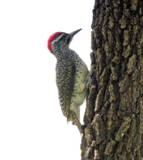 range-breasted Bushshrike, Northern White-crowned Shrike, Northern Fiscal, Fork-tailed Drongo, African Paradise Flycatcher, Pied Crow, Red-capped Lark, Dark-capped Bulbul, Red-faced Crombec, Tawny-flanked Prinia, Yellow-breasted Apalis, Rufous Chatterer, Superb Starling, Hildebrandt's Starling, Red-winged Starling, Spotted Ground-Thrush, White-browed Scrub Robin, African Grey Flycatcher, Variable Sunbird, Baglafecht Weaver, Red-billed Quelea, Black Bishop, Green-winged Pytilia, African Firefinch, Red-cheeked Cordon-bleu, Blue-capped Cordon-bleu, Crimson-rumped Waxbill, African Silverbill, Bronze Mannikin, African Pied Wagtail, Plain-backed Pipit, Reichenow's Seedeater and Streaky Seedeater.
range-breasted Bushshrike, Northern White-crowned Shrike, Northern Fiscal, Fork-tailed Drongo, African Paradise Flycatcher, Pied Crow, Red-capped Lark, Dark-capped Bulbul, Red-faced Crombec, Tawny-flanked Prinia, Yellow-breasted Apalis, Rufous Chatterer, Superb Starling, Hildebrandt's Starling, Red-winged Starling, Spotted Ground-Thrush, White-browed Scrub Robin, African Grey Flycatcher, Variable Sunbird, Baglafecht Weaver, Red-billed Quelea, Black Bishop, Green-winged Pytilia, African Firefinch, Red-cheeked Cordon-bleu, Blue-capped Cordon-bleu, Crimson-rumped Waxbill, African Silverbill, Bronze Mannikin, African Pied Wagtail, Plain-backed Pipit, Reichenow's Seedeater and Streaky Seedeater.
DAY 14
With our departure flight not until 20:40 it was decided to spend the morning in the reserve and return to the hotel for lunch before embarking on the long trek home. The reserve was surprisingly quiet on the birding-front this morning with just a couple of new species added. The hotel management allowed us to retain our hotel room so after another delicious lunch we were able to shower and pack at our leisure.
Although our trip back home was long and tedious, all flights were again bang on time arriving back in Birmingham 10 minutes early.
MOANS, GROANS & MEMORABLE MOMENTS
Moan
The shocking state of some of the roads, especially the road from Ngorongoro to the Serengeti. This is the only road to one of the iconic nature destinations in the world and it is little more than a dirt road, heavily rutted and caked with dust.
Groan
Watching young Americans cramming their plates with every offering on the sweet counter, then either taking a bite from each one and then leaving the rest, or eating half of what was on the plate and again discarding the rest. In a country where much of the population goes to bed hungry, it's a little insensitive to say the least.
Memorable Moments
Finally seeing Cheetah, an animal we have wanted to catch up with for many years.
The displaying Kori Bustard strutting his stuff, on a seemingly empty plain.
The 5 Greater Painted-snipe all feeding out in the middle of the Tarangire River was a total surprise.
Seeing the Pygmy Falcon, another bird we had dipped badly out on during several trips.
The resident Genets at Ndutu Lodge and watching Ainslie shooing them out of the dining room apologising and saying "they know they shouldn't be in here".
A member of the dining room staff at the Serena Hotel at Lake Manyara who was identical to Errol Brown the lead singer with "Hot Chocolate". We showed him a photo of Errol on the ipad and he asked "is that me?" In the next half an hour he escorted every member of the dining room staff, explaining the photo was him.
SUMMARY
This was a truly memorable holiday and many thanks must go to the staff at Birding Africa for organising a flawless trip.
Peter our Driver/Guide looked after us royally and his attention to detail was again very much appreciated.
We saw 248 bird species in total and 38 Mammals
Bird Species Trip List
Mammals Trip List
Bird Photos
Mammal Photos etc
Trip Preport PDF version
Pat & Judy Hayes

